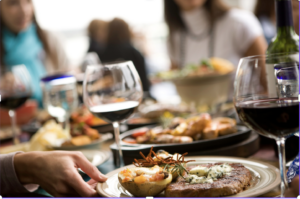
There are two easy ways to help matching wine with food: the complementary way and the contrast way.
The complementary idea involves selecting a wine that in some way is similar to the dish you will be serving, while the contrast principle involves combining wine with foods that are different in some way.
- The characteristics of a wine that can either resemble or contrast with the characteristics of a dish are:
The wine’s flavors:
Earthy, herbal, fruity, vegetal, and so on
The intensity of flavor in the wine:
Weak flavor intensity, moderately flavorful, or very flavorful
The wine’s texture:
Crisp and firm, or soft and supple
The weight of the wine:
Light-bodied, medium-bodied, or full-bodied
To apply either principle in the following sections, of course, you have to have a good idea of what the food is going to taste like and what various wines taste like. That second part can be a real stumbling block for people who don’t devote every ounce of their free energy to learning about wine. The solution is to ask your wine merchant. A retailer may not have the world’s greatest knack in wine and food pairings (then again, he may), but at least he should know what his wines taste like.
The complementary principle of wine and food
You probably use the complementary principle often without realizing it: You choose a light-bodied wine to go with a light dish, a medium-bodied wine to go with a fuller dish, and a full-bodied wine to go with a heavy dish.
- Some other examples of the complementary principle in action are:
Dishes with flavors that resemble those in the wine:
Think about the flavors in a dish the same way you think about the flavors in wine — as families of flavors. If a dish has mushrooms, it has an earthy flavor; if it has citrus or other elements of fruit, it has a fruity flavor (and so on). Then consider which wines would offer their own earthy flavor, fruity flavor, herbal flavor, spicy flavor, or whatever. The earthy flavors of white Burgundy complement risotto with mushrooms, for example, whereas an herbal Sancerre complements chicken breast with fresh herbs.
Foods with texture that’s similar to that of the wine:
A California Chardonnay with a creamy, rich texture can match the rich, soft texture of lobster, for example.
Foods and wines whose intensity of flavor match:
A very flavorful Asian stir-fry or Tex-Mex dish would be at home with a very flavorful, rather than a subtle, wine.
The contrast principle of wine and food
The contrast principle seeks to find flavors or texture in a wine that aren’t in a dish but that would enhance the dish.
Following are some examples that illustrate the contrast principle:
- A dish of fish or chicken in a rich cream and butter sauce may be matched with a dry Vouvray, a white wine whose crispness (thanks to its uplifting, high acidity) counterbalances the heaviness of the dish.
- A dish with earthy flavors such as Portobello mushrooms and fresh fava beans (or potatoes and black truffles) may contrast nicely with the pure fruit flavor of an Alsace Riesling.
You also apply the contrast principle every time you decide to serve simple food, like unadorned lamb chops or hard cheese and bread, with a complex aged wine.
Classic food and wine pairings
No matter how much you value imagination and creativity, there’s no sense reinventing the wheel. In wine-and-food terms, it pays to know the classic pairings because they work, and they’re a sure thing.
Here are some famous and reliable combinations:
- Oysters and traditional, unoaked Chablis
- Lamb and red Bordeaux (Chianti is good with lamb, too)
- Port with walnuts and Stilton cheese
- Salmon with Pinot Noir
- Amarone with Gorgonzola cheese
- Grilled fish with Vinho Verde
- Foie gras with Sauternes or with late-harvest Gewürztraminer
- Braised beef with Barolo
- Dry amontillado Sherry with soup
- Grilled chicken with Beaujolais
- Toasted almonds or green olives with fino or Manzanilla Sherry
- Goat cheese with Sancerre or Pouilly-Fumé
- Dark chocolate with California Cabernet Sauvignon


